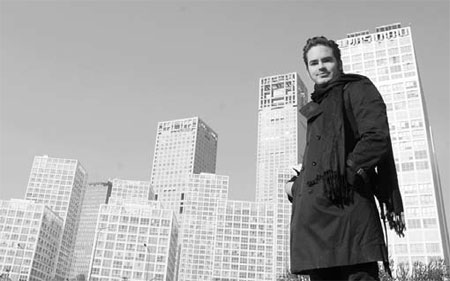Architect finds space for his brand of talent
Updated: 2012-04-01 08:07
By Alexandra Leyton Espinoza (China Daily)
|
|||||||||||
|
Simon Persson finds a lot to like in China's evolving architecture. Provided to China Daily |
Swedish-born Simon Hjalmar Persson, 29, believes his first career inspiration came when he read The Fountainhead, a story about a young architect who chooses to struggle in obscurity rather than compromise his artistic and personal vision. His mother lent him the book at the age of 14.
"All architects probably have their pseudo reasons to join the profession," he says, laughing. "My favorite one is when George Costanza in Seinfeld says he is an architect and instantly gets women's attention."
"Today, architecture is an opportunity to express myself and my creative curiosity in space." However naive it makes him sound, he says his goal is always "to add layers of meaning rather than just solve a problem".
After five years of education at Aarhus School of Architecture in Denmark, combined with studies in Japan, Norway and the Netherlands, Persson decided Asia was the place for him.
" I wanted to go back to Japan, but the country was going through a financial crisis and they have the most architects in the world. So I thought, 'China is close to Japan' and I started looking into the Chinese market."
The Chinese government has awarded some of its biggest projects to foreign architects. The "Bird's Nest" stadium was designed by Swiss architects, while a Dutchman designed the new headquarters for China's state television network, CCTV. So there is no doubt foreign architects are welcomed in China.
But it was the Beijing-based professionals that intrigued Persson.
"I noticed at once that there were a lot of small design offices," he says. "A new generation of Chinese architectures that didn't do Chinese traditional architecture or copied Western architecture, instead elaborated with contemporary global architecture free from historical references.
Persson recognized that China wasn't anything like Japan but he was positively surprised by the country's modernity.
"I presumed China was much more Wild East rock 'n' roll of ruckus," he says.
He soon nailed a job at one of China's most respected architecture companies, Standard Architecture.
"The company is uncompromising and don't believe in selling themselves out. The management is also non-typical Chinese with a less hierarchical tone. Everyone is involved in developing ideas and results."
Last year, one of Persson's projects was the "egg house". The original idea, to create a compact house for migrant workers to live and work, was followed up by a mutant version built by a staff member of bamboo, wood and grass seed.
"They were supposed to be able to be business owners and decrease their living costs by working and living in these 'eggs'. They could run their karaoke houses, massage houses and other services," he says.
At a time when exploding rents and property prices were a hot topic in the capital, some questioned whether the company was making a political statement.
"It is a sensitive topic and the police asked us to remove the egg," Persson recalls. The egg is now mutating again, as a safe capsule resistant to tsunamis and earthquakes.
Meanwhile, skyscrapers seem to be built on a daily basis - though bad planning, developing and money issues has stopped many projects during the rush to finish projects quickly, according to Persson.
But "China will be a leading player in the architecture scene - here is where the money is. It's becoming a global workspace. As the country continues to develop, young Chinese architectures will be given chances no students in Sweden will ever get," he says.
sundayed@chinadaily.com.cn
Today's Top News
Rescuers race against time for quake victims
Telecom workers restore links
Coal mine blast kills 18 in Jilin
Intl scholarship puts China on the map
More bird flu patients discharged
Gold loses sheen, but still a safe bet
US 'turns blind eye to human rights'
Telecom workers restore links
Hot Topics
Lunar probe , China growth forecasts, Emission rules get tougher, China seen through 'colored lens', International board,
Editor's Picks

|

|

|

|

|

|






